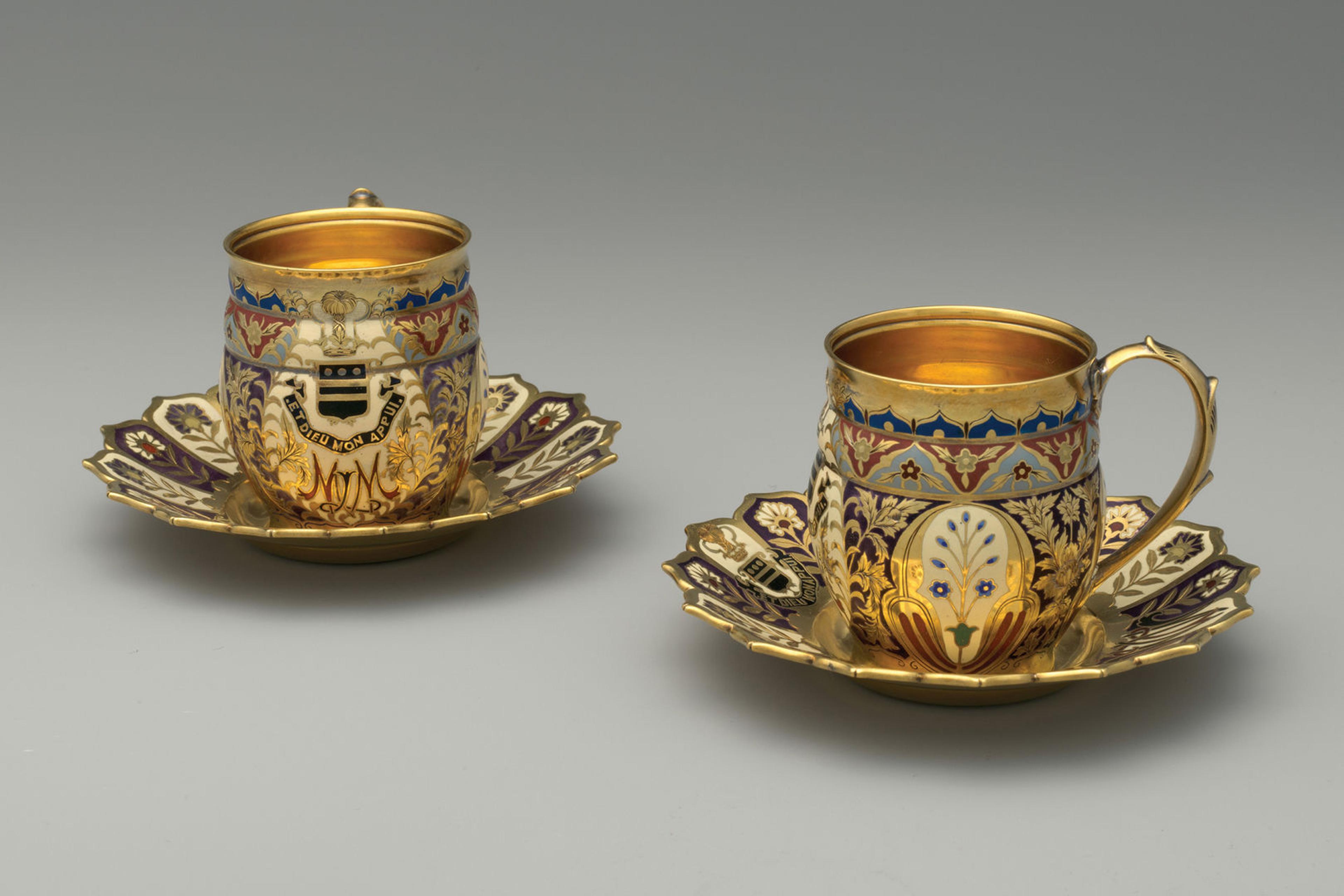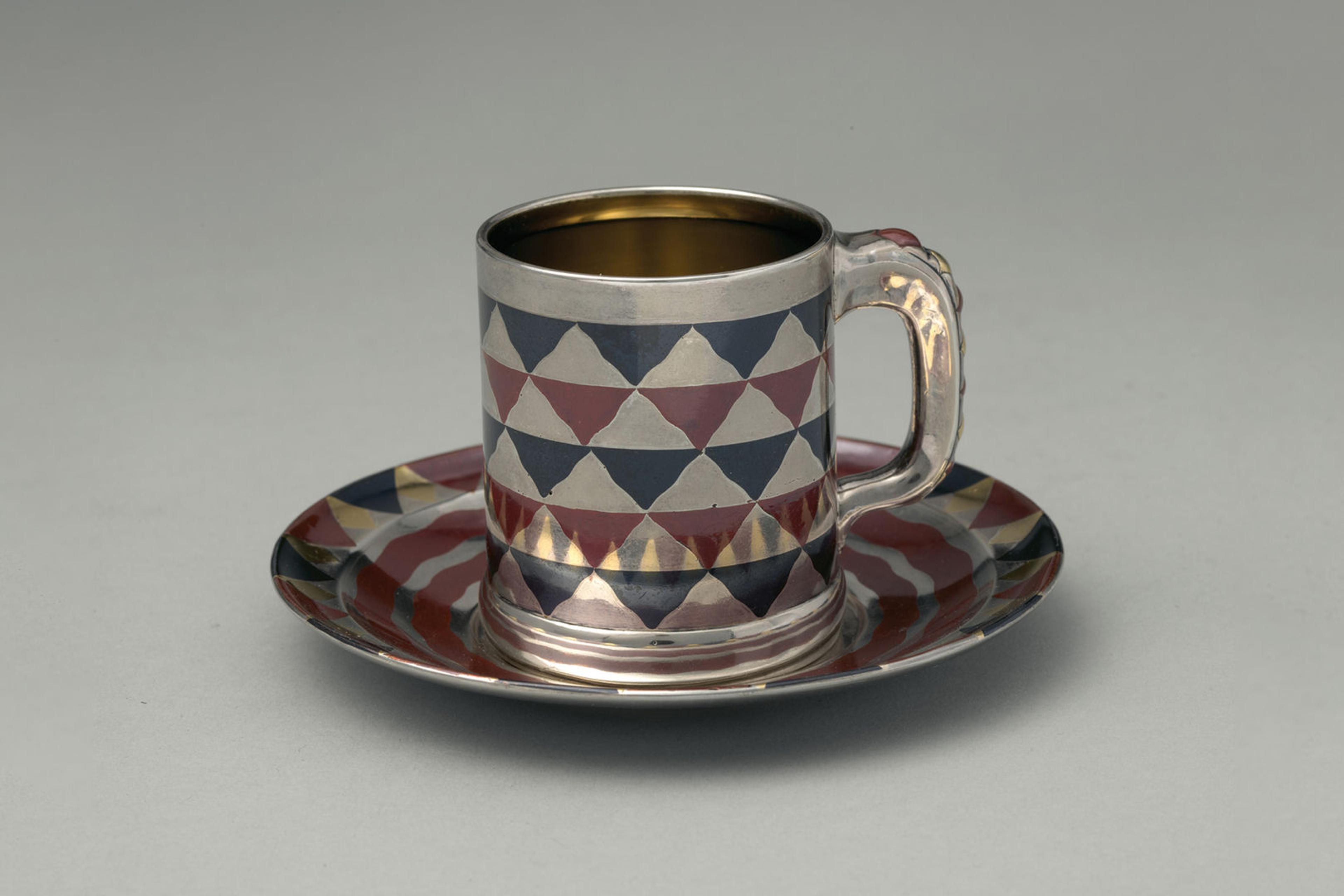Learn how Tiffany & Co. employed the metalworking technique of electrolytic etching with illustrative artworks and process demonstrations.

Tiffany & Co. (American, 1837–present). Two cups and saucers from the Mackay Service, 1878. Silver, silver-gilt and enamel, 2 1/2 × 2 × 2 3/4 in. (5.7 × 5.1 × 7 cm). The Metropolitan Museum of Art, New York, Purchase, Cranshaw Corporation Gift, 2017 (2017.196.1-.4)
Electrolytic etching describes a metalworking technique in which the surface of a metal object is etched by submerging it in an electrically conductive solution and applying electricity as direct current. Introduced in the nineteenth century, this technique was used by craftspeople, such as those at Tiffany & Co., to create recesses in the surfaces of objects for adding enamels or metal inlays. This technique is closely related to electrolytic inlay, which uses direct current to plate metallic ions onto the surface of metal objects. The two techniques were often used in conjunction, etching a recess in one solution and filling it with a different metal in another.

Tiffany & Co. (American, 1837–present). Cup and saucer, ca. 1881. Silver, patinated copper, patinated copper-platinum-iron alloy, and gold, cup: 2 1/8 x 2 1/2 x 1 7/8 in. (5.4 x 6.4 x 4.8 cm); saucer: 1/2 x 4 in. (1.3 x 10.2 cm). The Metropolitan Museum of Art, New York, Purchase, Friends of the American Wing Fund and Emma and Jay A. Lewis Gift, 2016 (2016.688a, b)
The electrically conductive solution, the electrolyte, is prepared by mixing table salt with distilled water in a plastic or a glass container. On its own, distilled water is a poor conductor of electricity; adding salt makes the solution more conductive. Seen below, the copper coupon—a small piece of metal—to be etched is prepared by lightly polishing with an abrasive, like pumice, and rinsing off any residue. This removes dust, grime, fingerprints, and other accretions from the surface.
A resist—a material that serves as a protective layer—is applied to the surface of the metal coupon. The resist will control where the surface is etched by the solution. Nineteenth-century craftspeople would have used various waxes and natural resins as resists both alone and in combination. In the example below, the artisan uses laser-cut vinyl.
After the resist is applied, the copper coupon is suspended in the salt solution. A coupon with no resist is suspended, as well; this is required in order to create a complete circuit. Both are hooked up to a direct current source known as a rectifier, which is used to convert alternating current from a wall socket into the direct current and allows the craftsman to control the direction of the electricity. The plain copper coupon is hooked up to act as the negatively charged cathode, and the copper with the resist is hooked up to act as the positively charged anode.
When the current is applied, an oxidation reaction occurs on the surface of the anode, the copper coupon with the resist. Atoms on the metal surface lose electrons, transforming them into positively-charged copper ions. These ions are attracted to the negatively charged cathode, causing them to migrate towards the copper coupon without the resist. Positively charged hydrogen ions in the electrolyte will also move towards the cathode and combine to form hydrogen gas bubbles.
This migration of positively charged copper ions continues until the desired depth has been achieved. Then the current is turned off and the newly etched coupon is removed from the solution.
Next, the vinyl resist is peeled off and any adhesive residue is removed by lightly polishing with pumice and rinsing off any slurry, a mixture of pumice and distilled water, left on the surface.
Watch a video of the entire electrolytic etching process, including an additional step of enameling:
